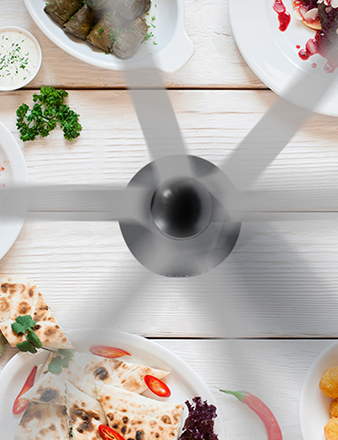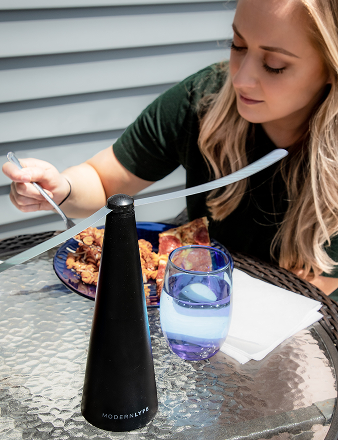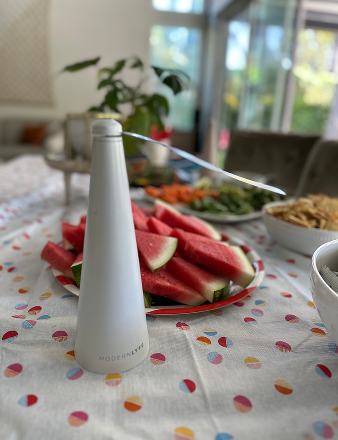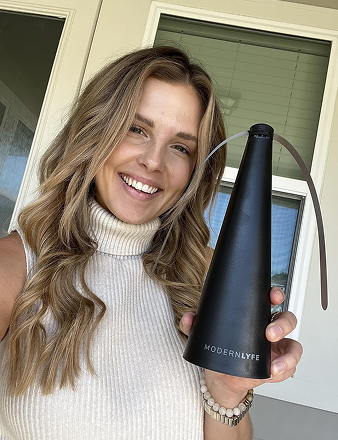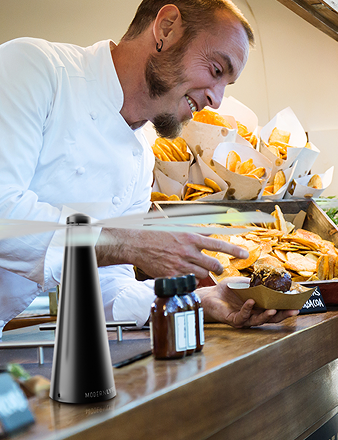Commercial kitchens run on more than just ranges and walk-in coolers. The real workhorses—the tools that define a kitchen's speed and safety—are the accessories. These are the prep tools, storage systems, and safety gear that support every dish that leaves the pass.
Build Your Kitchen’s Operational Backbone
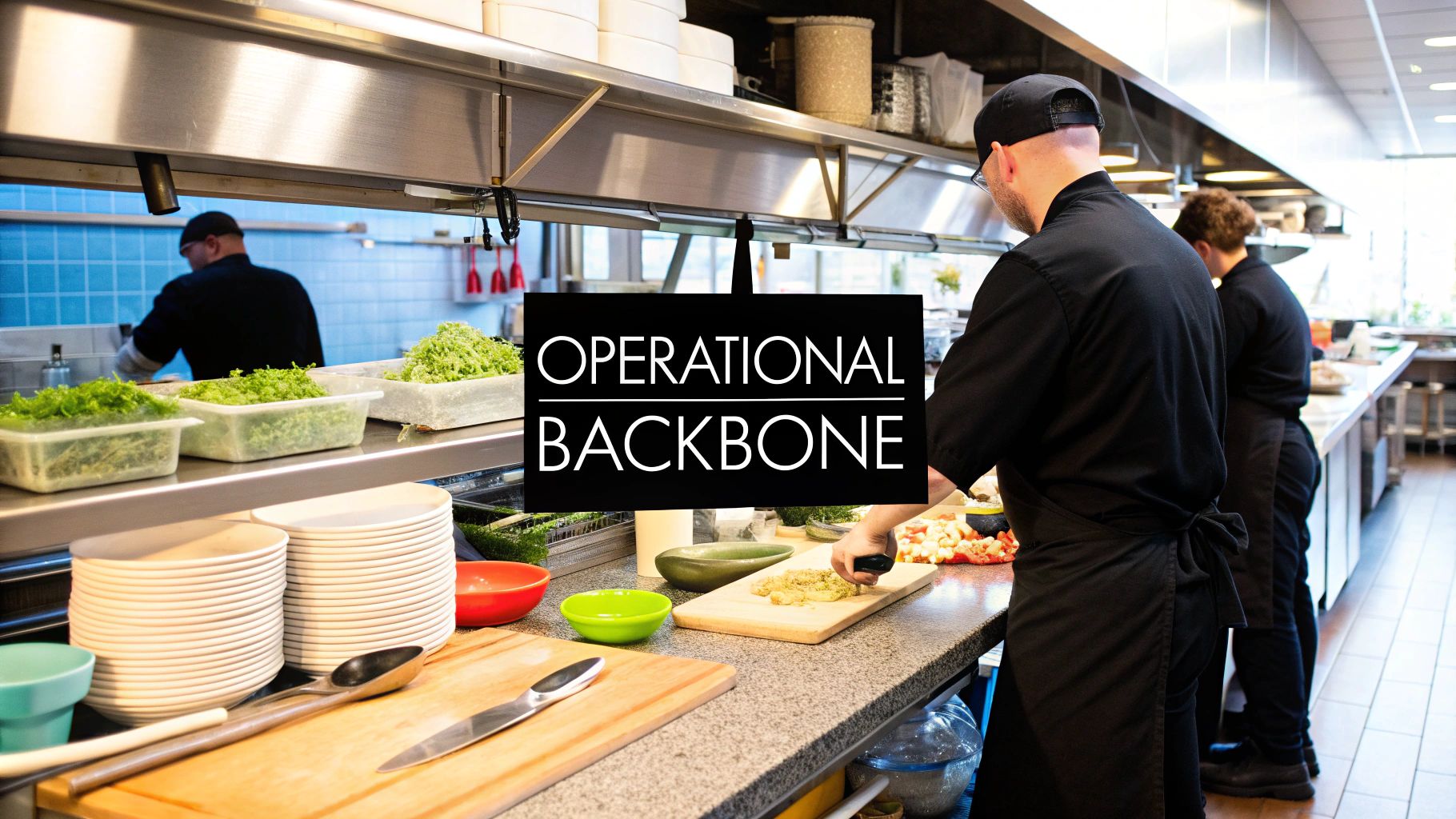
A great restaurant's soul isn't just in its major equipment. It's in the ecosystem of accessories that lets a talented kitchen staff perform at their best.
Think of it this way: your ovens and grills are a race car's engine. They provide the power. But without the right tires, steering, and transmission—the accessories—that engine is just a loud piece of metal. Commercial kitchen accessories translate that power into precise, effective, and repeatable action.
More Than Just Gadgets
These items are a direct investment in your kitchen’s success. The right set of tools has a measurable impact on everything from ticket times to staff safety, and the industry is taking notice.
The global demand for smarter, more efficient cooking solutions is booming. The commercial cooking equipment market is projected to grow from USD 13.3 billion in 2025 to USD 26.5 billion by 2035. This isn’t just about big appliances; it signals a clear industry focus on optimizing every kitchen component, especially the accessories that keep things running smoothly.
The Foundation of Efficiency and Safety
Choosing your accessories carefully transforms your workflow and food consistency. They are the quiet workhorses that empower your team to execute flawlessly, service after service.
A kitchen with the right gear gains serious advantages:
- Increased Speed: The right tool shaves seconds off repetitive tasks, adding up to minutes during a busy rush.
- Enhanced Consistency: Precise measuring tools, portioners, and molds ensure the 100th plate looks and tastes as perfect as the first.
- Improved Staff Morale: Fighting with bad equipment is frustrating. Giving your team the tools they need shows you respect their craft.
- Superior Safety: Non-slip mats, cut-resistant gloves, and proper ventilation are essential for a safe work environment.
Take airflow, for example. It's a fundamental part of kitchen safety and comfort. To dive deeper, check out our guide on commercial kitchen ventilation systems.
Ultimately, these accessories are the building blocks of a professional, safe, and highly productive kitchen.
The Three Pillars of a Well-Equipped Kitchen
Outfitting a commercial kitchen is more than buying big-ticket items. The secret to a smooth, safe, and profitable operation lies in the accessories. Instead of making a random shopping list, think about them in three distinct categories.
This framework helps you build a complete system. We can break down kitchen accessories into three core pillars: Preparation & Cooking Tools, Storage & Organization, and Safety & Sanitation. If one is weak, the whole structure suffers.
This diagram shows how these three pillars work together.
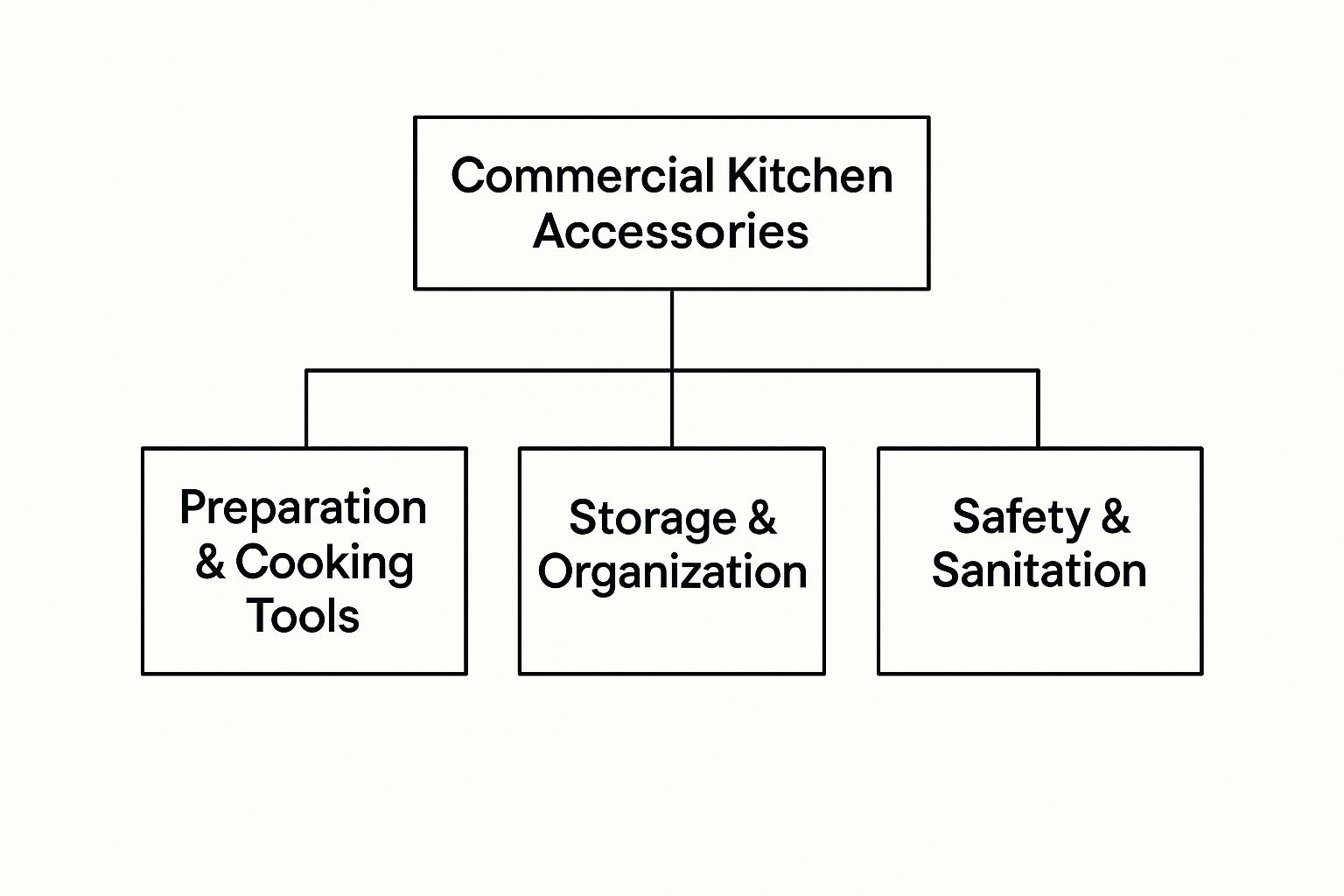
It’s all about balance. A kitchen with the best knives won’t function well if storage is chaotic and safety gear is missing.
Preparation and Cooking Tools: The Tools of the Trade
These are the items your team uses all day, every day. They are the frontline workhorses that turn raw ingredients into finished dishes. Think of a chef's knife, a whisk, or a sauté pan—they're the direct link between a cook's skill and the final plate.
Quality here is critical. A sharp knife means faster, safer prep. A heavy-bottomed pan ensures even cooking without hot spots. Investing in good tools pays off in consistency, speed, and food quality.
Key examples in this pillar include:
- Cutlery and Cutting Boards: High-quality chef’s knives, paring knives, serrated knives, and color-coded cutting boards to prevent cross-contamination.
- Cookware and Bakeware: A full suite of pots, pans, sheet pans, and specialty molds tailored to your menu.
- Mixing and Measuring Tools: Stainless steel mixing bowls, whisks, spatulas, measuring cups, and portion scales for recipe consistency.
Storage and Organization: The Backbone of Efficiency
If prep tools are the actors on stage, storage and organization are the backstage crew—essential but often unseen. This pillar brings order to the controlled chaos of a busy kitchen. When everything has a place, your team can find what they need in seconds.
Good organization is a direct driver of efficiency and food safety. Studies on kitchen ergonomics show that a well-organized station can cut wasted movement and physical strain by over 20%. That means faster ticket times and a less-fatigued crew.
A disorganized walk-in or prep station is a direct drain on profitability. Every minute spent searching for an ingredient is a minute not spent cooking.
This pillar brings structure to your space:
- Shelving and Racks: Dunnage racks to keep items off the floor and heavy-duty wire shelving for dry storage and walk-ins.
- Food Storage Containers: Cambro containers, ingredient bins, and food pans in various sizes to keep ingredients fresh and organized.
- Racks for Transport and Holding: Sheet pan racks for cooling baked goods or holding prepped items for service.
Safety and Sanitation: The Non-Negotiables
This final pillar is the most important. It protects your staff, your customers, and your business's reputation. Safety and sanitation gear is a legal and ethical must—your best defense against accidents, injuries, and foodborne illnesses.
From non-slip floor mats to first-aid kits, this category covers everything that keeps your environment hygienic and secure. A simple wet floor sign can prevent a costly slip-and-fall, one of the most common industry injuries. Think of this as risk management that protects your people and your bottom line.
Here’s how these pillars translate into specific items for your kitchen:
| Category Pillar | Function | Essential Accessory Examples |
|---|---|---|
| Prep & Cooking | Food Preparation | Knives, cutting boards, mixing bowls, food processors |
| Prep & Cooking | Cooking & Baking | Pots, pans, sheet pans, whisks, spatulas, tongs |
| Prep & Cooking | Measurement & Plating | Portion scales, measuring cups/spoons, plating tools |
| Storage & Org. | Ingredient Storage | Food pans, ingredient bins, food labels, dunnage racks |
| Storage & Org. | Equipment Organization | Wire shelving, wall-mounted racks, knife magnets/blocks |
| Storage & Org. | Transport & Holding | Sheet pan racks, utility carts |
| Safety & Sanitation | Personal Safety | Cut-resistant gloves, non-slip shoes, oven mitts |
| Safety & Sanitation | Food Safety | Food thermometers, color-coded tools, sanitizing solution |
| Safety & Sanitation | General Sanitation | Mop buckets, wet floor signs, hand soap dispensers |
Each item plays a specific role, working together to create a kitchen set up for success.
Choosing Materials That Withstand the Pressure
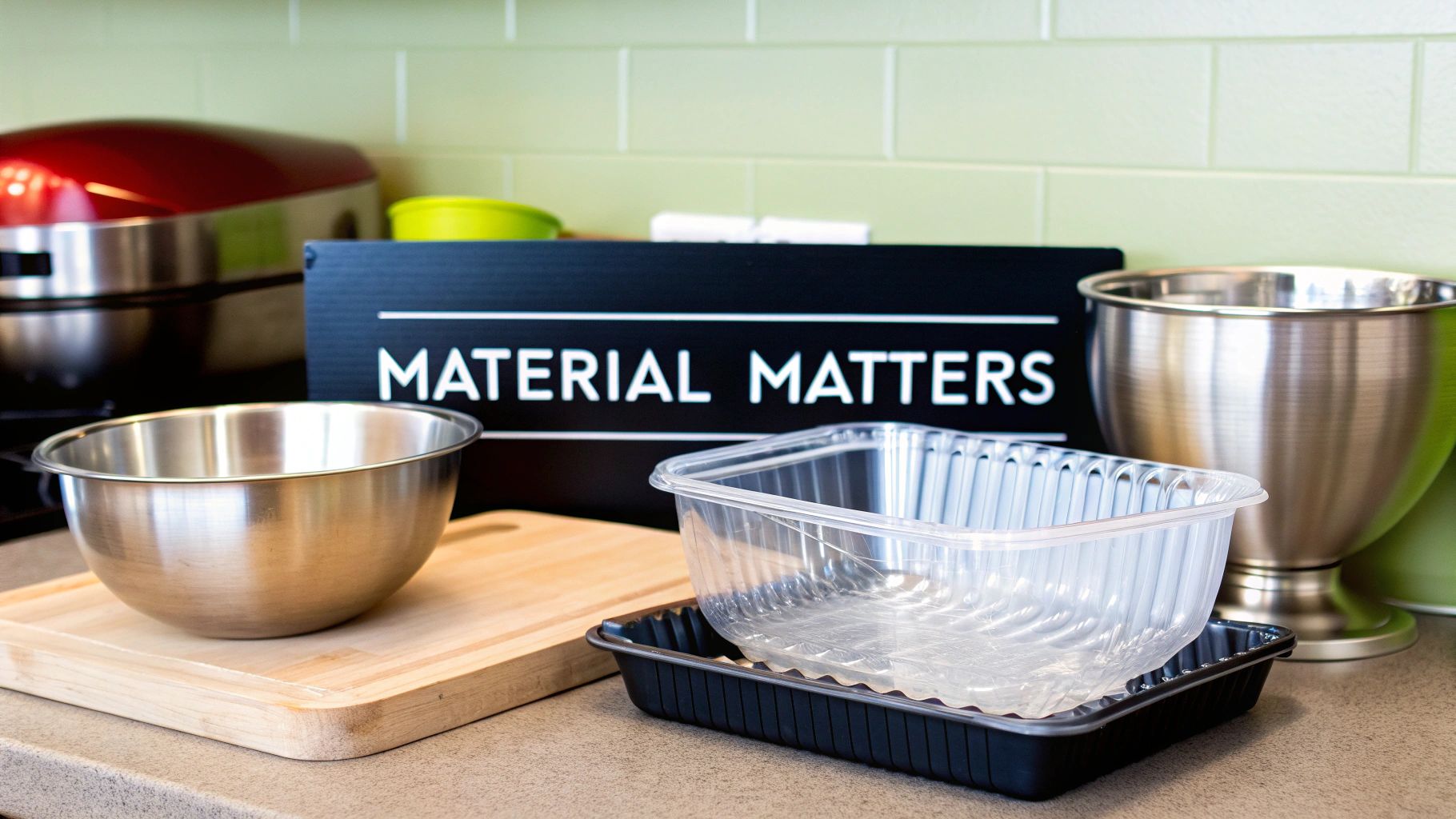
A tool’s material is its backbone. It determines its strength, lifespan, and performance under pressure. In a commercial kitchen—a place of constant heat, high traffic, and harsh chemicals—choosing the right material is a core business decision.
Think of it like building a house in a hurricane zone. You wouldn’t use flimsy materials; you'd use reinforced steel. The same logic applies to your kitchen accessories, where the "hurricane" is the relentless pace of dinner service.
Stainless Steel: The Undisputed Champion
When you need toughness and food safety, stainless steel is king. It’s non-porous, meaning it won’t trap bacteria, absorb odors, or retain flavors. This makes it incredibly easy to clean and sanitize—a huge win in any professional kitchen.
Not all stainless steel is the same. You'll see numbers like 18/8 or 304-grade. This refers to the amount of chromium and nickel, which gives it impressive rust and corrosion resistance. For almost anything that touches food, 304-grade stainless steel is the gold standard, offering the perfect blend of strength and longevity.
It's the go-to for high-use items that must be bulletproof and hygienic:
- Work Tables and Prep Surfaces: They take a beating from chopping, spills, and sanitizing without breaking down.
- Mixing Bowls and Stock Pots: They won't react with acidic ingredients like tomatoes or vinegar, so your food's flavor stays pure.
- Food Pans and Utensils: Their strength means they won’t dent or bend, even after months of heavy use.
Aluminum: The Lightweight Contender
Aluminum is another major player in professional kitchens, primarily because it’s lightweight and a fantastic heat conductor. That thermal conductivity is why it's used so often for sauté pans and baking sheets. It heats up fast and spreads heat evenly, preventing hot spots that can burn food.
Of course, aluminum has downsides. It’s softer than steel, so it's more likely to dent, scratch, or warp. It can also react with highly acidic or alkaline foods, which can affect taste or discolor the pan. That's why much commercial aluminum cookware is "anodized" for a harder surface or lined with a non-reactive material.
The choice between stainless steel and aluminum is usually a trade-off between heat conductivity and raw durability. Need quick, even heating? Go with aluminum. For everything else that needs to last, stick with stainless steel.
Plastics and Synthetics: The Versatile Specialists
Modern kitchens can't run without plastics and synthetics. Food-grade options like high-density polyethylene (HDPE), polycarbonate, and silicone have essential roles because they offer unique benefits metals can't match. They’re light, generally cheaper, and can be molded into any shape.
Color-coded cutting boards are usually made from HDPE to prevent cross-contamination. Those clear, nearly indestructible food storage containers? That’s polycarbonate, letting you see contents at a glance. And flexible, high-heat spatulas and non-stick baking mats are almost always silicone.
The most important thing is to ensure any plastic accessory is NSF-certified. This guarantees it's safe for food contact and built to withstand a commercial kitchen. Understanding your options is key, and a guide on choosing the right cookware materials can help you make smarter purchasing decisions.
A well-equipped kitchen uses a smart mix of all three materials, playing to their individual strengths to build an arsenal of effective, long-lasting tools.
Matching Your Tools to Your Menu
Don't just buy everything on a checklist. What works for a massive hotel restaurant would be a disaster in a food truck. Let your menu and service style dictate every purchase. Every tool should solve a problem you actually have.
Buying without a clear strategy leads to wasted space, clunky workflows, and a lighter wallet. Take a hard look at how you operate and invest only in the accessories that truly pull their weight.
This strategic thinking is non-negotiable. As kitchens shrink, manufacturers are pushed to create smarter, more efficient equipment. That’s a big reason why the global food service equipment market, valued at USD 49.51 billion in 2025, is expected to climb to USD 82.24 billion by 2034. This boom is all about compact, multi-purpose gear that helps chefs do more with less. Explore the trends in this food service equipment market research on PrecedenceResearch.com.
The High-Volume Restaurant Approach
In a busy restaurant, two things matter above all else: durability and capacity. The kitchen is a warzone, and your gear has to survive the nightly battle. This is where heavy-duty, high-volume equipment earns its keep.
Think sprawling stainless-steel prep tables, industrial-sized food processors, and enough walk-in shelving to hold a mountain of ingredients. These are the backbone of speed and consistency when you're operating at scale.
Here’s where a high-volume restaurant should focus its budget:
- High-Capacity Storage: Go big. Large ingredient bins, heavy-duty dunnage racks, and full-size hotel pans are critical for managing bulk inventory.
- Durable, Heavy-Duty Tools: Invest in forged chef's knives that hold an edge, thick-gauge stainless steel pots that won't warp, and commercial-grade immersion blenders.
- Specialized Stations: To keep the line moving, each station needs dedicated tools. Plating tweezers at the pass, specific pans at the sauté station—it all prevents bottlenecks.
The Compact Food Truck Strategy
On a food truck, every inch is prime real estate. The game is squeezing the most function out of a tight space. Your strategy has to be ruthless: find accessories that are compact, lightweight, and can do more than one job.
A food truck owner has to think like a minimalist. Every tool needs to pull double or triple duty, and every storage solution must leverage vertical and under-counter space.
One appliance that can chop, blend, and mix is infinitely more valuable than three separate machines. Under-counter fridges, wall-mounted magnetic knife strips, and stackable containers are the building blocks of an efficient mobile kitchen.
Key accessories that make or break a food truck:
- Multifunctional Appliances: A combi oven that also steams or a high-powered blender that tackles both smoothies and soups is a game-changer.
- Vertical and Compact Storage: Wall-mounted shelves, magnetic strips, and nesting containers are essential for keeping a tiny kitchen organized and safe.
- Portable and Lightweight Gear: Everything needs to be easy to move, secured for transit, and tough enough to handle being on the road.
The Mobile Catering Business Focus
Caterers operate in a hybrid world between a restaurant and a food truck. They need high-capacity tools for prep and a different set of equipment to transport food safely and in perfect condition.
For caterers, the focus shifts to off-site service logistics. The most vital commercial kitchen accessories are those that ensure food arrives at the venue looking and tasting incredible. That means a heavy investment in insulated carriers, portable warmers, and durable serving gear.
Caterers should prioritize gear for transport and presentation:
- Insulated Transport: High-quality insulated food pan carriers are essential for holding food at safe temperatures for hours.
- Portable Holding Equipment: Electric holding cabinets and portable induction burners are your best friends for on-site reheating and finishing touches.
- Elegant Presentation Gear: Your setup is part of the show. Professional chafing dishes, beautiful serving utensils, and stylish beverage dispensers are crucial for a buffet line that wows guests.
Extending the Lifespan of Your Kitchen Tools
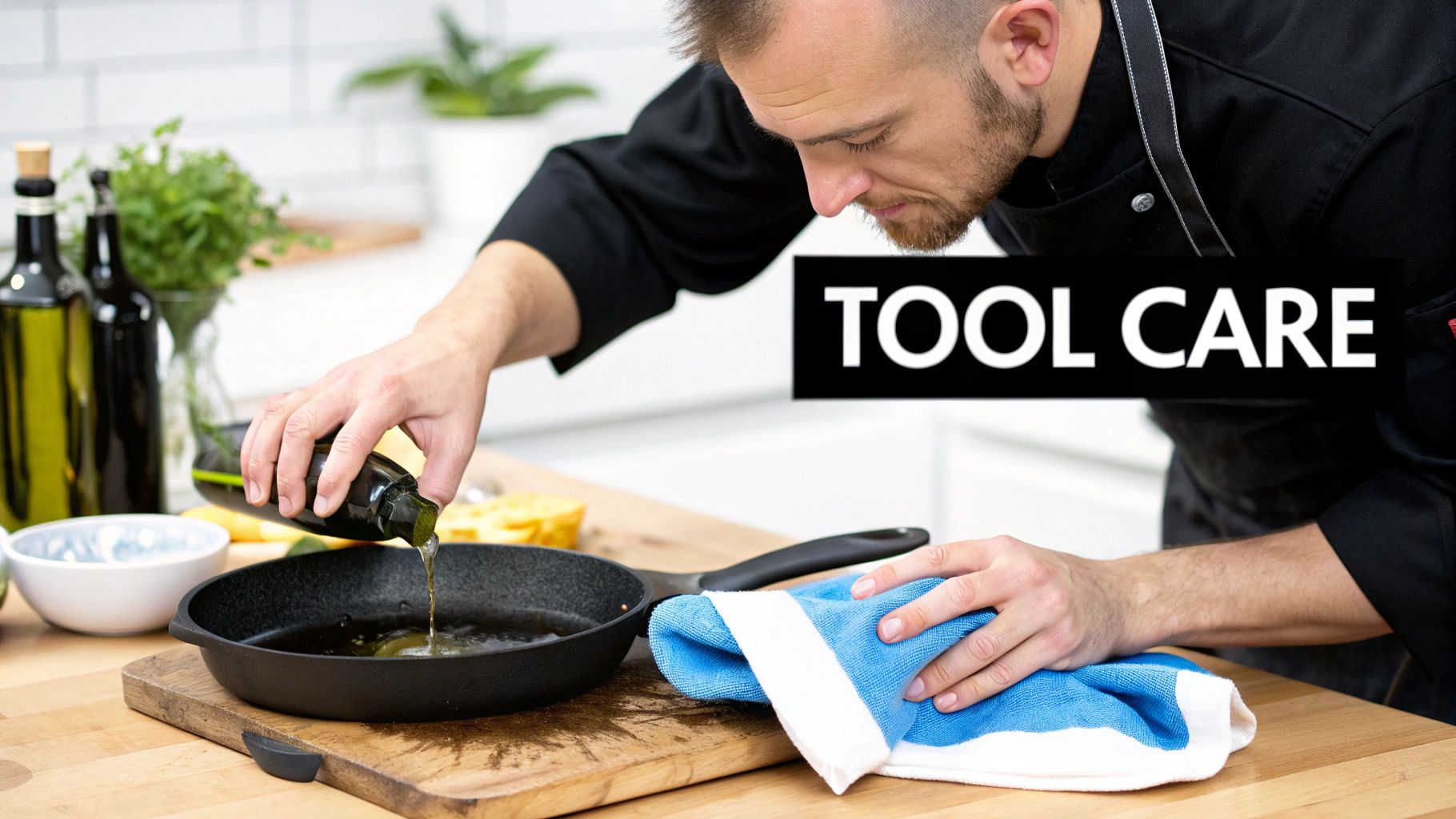
You've invested in high-quality commercial kitchen accessories. Like any valuable asset, they need proper care to deliver a return. Real longevity comes from preventative maintenance, not just a quick scrub at the end of the night.
Think of it this way: you wouldn't just wash your car and expect it to run forever without an oil change. Proactive care stops minor issues from turning into major headaches, saving you money and keeping your results consistent.
Material-Specific Care Strategies
Every material has its own rules. A one-size-fits-all approach can cause serious damage. You’d never take steel wool to a non-stick pan, and the same principle applies here.
Knowing the needs of each material is the first step toward making your gear last.
- Stainless Steel: This kitchen workhorse isn't invincible. Avoid abrasive pads and steel wool, which scratch the surface and invite corrosion. A proper stainless steel polish will keep its protective layer intact.
- Cast Iron: Seasoning is everything. It creates a natural non-stick surface. Clean it with a stiff brush and hot water (no soap!), dry it completely, and wipe on a thin layer of cooking oil before storing.
- Wooden Tools & Cutting Boards: Wood is porous, so never let it soak. A quick wash with mild soap, a fast rinse, and immediate drying are key. Sanitize and condition it with a vinegar solution and occasional food-grade mineral oil.
The Power of a Maintenance Schedule
The best maintenance plan is one you actually follow. Create a simple schedule to take the guesswork out of the equation and ensure every tool gets the attention it needs. A checklist is your best friend.
Preventative maintenance isn’t an expense; it’s an operational strategy. A well-maintained tool lasts longer and performs better, directly impacting food quality and kitchen safety.
A solid schedule breaks tasks into daily, weekly, and monthly duties. Mastering correct cleaning methods is essential. For instance, if you have stone countertops, learning how to clean natural stone surfaces safely and effectively will prevent costly damage.
This all ties directly into hygiene. For a deeper dive, check out our guide on food safety restaurant guidelines. Making these practices a habit protects your investment, your customers, and your reputation.
Your Smart Procurement Checklist
Let's talk about the final step: buying the gear. Smart purchasing separates a profitable kitchen from one that's constantly struggling. This isn't about chasing the lowest price; it's about investing in tools that deliver long-term value. A strategic approach will save you money, prevent headaches, and give your team what they need to succeed.
Use this checklist as your game plan for navigating the market and making informed choices.
Assess Your Real-World Needs
Before you open a catalog, stop and look at your actual operation. The biggest mistake is buying for an imaginary kitchen instead of the one you work in every day.
Get honest with yourself. Ask these key questions to determine what you truly need.
- What drives your menu? Invest in accessories that make producing your best-sellers faster and easier.
- How's your space? A sprawling kitchen can accommodate single-task items, while a compact one demands multi-functional tools.
- Where are your bottlenecks? Watch your team during a busy service. Where do things slow down? Buy accessories that solve those exact pain points.
Answering these questions first prevents impulse buys that don't solve real problems.
Prioritize Quality and Certification
When buying commercial kitchen gear, the sticker price is just the beginning. A cheap pan that warps in six months is more expensive in the long run than a quality one that lasts for years.
Always look for the NSF (National Sanitation Foundation) certification on anything that touches food. This mark is your assurance that the item is made from food-safe materials, can be properly cleaned, and is built to withstand a professional kitchen. Consider it a non-negotiable seal of quality.
This focus on quality is critical. The U.S. commercial cooking equipment manufacturing market hit $8.4 billion in 2025, driven by demand for high-performance equipment. This is part of a global market valued at over USD 112 billion, showing just how vital reliable gear is. You can dive deeper with this commercial cooking equipment market data on IBISWorld.com.
Evaluate Suppliers and Long-Term Value
Finally, think about who you're buying from. A good supplier is a partner, offering solid warranties, reliable customer service, and expert advice.
When comparing options, look past the initial price and consider the total cost of ownership. A slightly pricier, energy-efficient freezer might save you thousands in electricity bills. A well-crafted knife that holds its edge means less time sharpening and fewer replacements.
While making big investments, don't overlook small things that boost hygiene and comfort, like the solutions in our guide to commercial fly fans. The ultimate goal is to strike the perfect balance between what you pay today and the value you get for years to come.
Kitchen Accessory FAQs
Even seasoned chefs and managers have questions when stocking or upgrading a kitchen. Let's tackle some of the most common questions about choosing and managing kitchen tools.
Think of this as your quick-fire round for making those final, crucial decisions.
What’s the Single Most Important Thing to Look for in an Accessory?
Hands down, durability. A commercial kitchen is a brutal environment, and flimsy tools don't survive. You need accessories built from tough materials—like heavy-gauge stainless steel or high-density polycarbonate—that can handle the heat, constant use, and aggressive cleaning.
My best advice? Always look for the NSF certification. That seal is your guarantee that the item is food-safe and built to last in a professional kitchen. It’s a non-negotiable.
How Should I Organize Accessories to Make My Kitchen Faster?
The secret is to think in "zones." Group tools for a specific job—prep, grilling, plating—and keep them right where that job happens. It cuts out wasted time and motion when tickets are flying.
Here are a few ways to put that into practice:
- Use wall-mounted magnetic strips for knives at the prep station.
- Get clear, labeled bins for dry goods so you can see what you have at a glance.
- Use color-coded cutting boards and utensils to prevent cross-contamination.
"A well-organized station isn't just about being tidy—it's about smart ergonomics. It directly leads to faster ticket times and less stress on your team. Every second you save not looking for a peeler adds up."
Should I Splurge on Specialty Gadgets or Stick to Multi-Use Tools?
For most kitchens, versatile, multi-functional tools are the smarter buy. You'll save money and precious counter space. A quality immersion blender can handle soups, sauces, and dressings, replacing several other gadgets. This is especially true in smaller kitchens.
Only buy a specialized tool if it's for a signature menu item you make constantly, in huge batches. If it won't solve a daily problem or dramatically speed up a core dish, it will probably just collect dust. By focusing on versatile workhorses, you’ll build a lean, powerful collection of commercial kitchen accessories that works for your menu and your budget.
Ready to create a more comfortable and hygienic dining environment? Explore the elegant and effective fly fan solutions from MODERN LYFE to protect your food and impress your guests. Visit https://modernlyfe.com to find the perfect addition to your setup.

